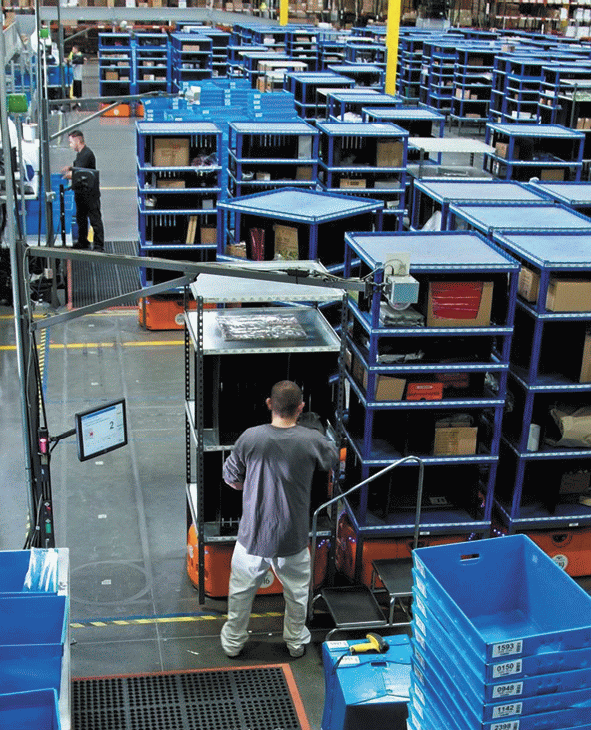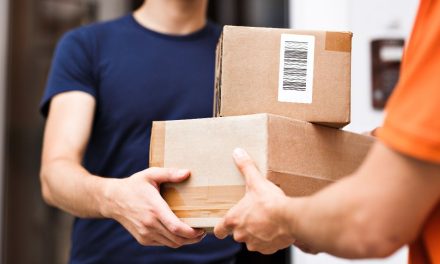 Advertisement feature
Advertisement feature
Smarter, faster technology to process offers at distribution and fulfilment centres has finally arrived with the emergence of mobile-robotics, according to senior director of marketing for Kiva Systems, Peter Blair
Today, people are shopping smarter. They are using sophisticated technology to research product options and prices and to execute those purchases. So why is it that on the operational side, the process to fill orders at the distribution and fulfilment centre are still very traditional, and often manual? Why hasn’t the technology to support this trend on the consumer end, been matched with smarter, faster technology on the distribution and fulfilment end? Now – it finally has.
Traditional warehouses often use conveyors, sorters or carousel systems that involve miles of loud metal and rubber equipment bolted-down in winding patterns. These systems require complicated installations, are inflexible to modifications, and are vulnerable to single points-of-failure. Further, reconfiguring a conveyor system to introduce a new function requires a significant disruption to operations. Many distribution centres (DCs) use a manual process for materials handling where workers walk up to 14 miles per day, hunting through aisles of inventory shelving and gathering merchandise into carts. This is slow, inaccurate, and expensive because of the manual labor required.
Now, suppliers are realising what was a practical system for their DC 10 years ago, no longer works with today’s multi-disciplined demands. These companies need a DC that can offer:
• Small  orders shipped more often: Retailers want to keep store inventory levels lower, but stock-outs are unacceptable. This forces DCs to pick smaller orders and ship them more often. In the past where products might be picked and shipped as full pallets or full cases once every two weeks, today it is common to pick the same products as single cases and split-case quantities while shipping to each store multiple times a week. Old DC efficiencies are lost in this environment.
orders shipped more often: Retailers want to keep store inventory levels lower, but stock-outs are unacceptable. This forces DCs to pick smaller orders and ship them more often. In the past where products might be picked and shipped as full pallets or full cases once every two weeks, today it is common to pick the same products as single cases and split-case quantities while shipping to each store multiple times a week. Old DC efficiencies are lost in this environment.
• SKU proliferation and demand variability: Because today’s trend could be tomorrow’s clearance item, product demand profiles can change overnight and new SKUs can be introduced at any point to the DC. Businesses need to be prepared to adapt quickly to the constant flux within their DC while maintaining high levels of productivity and service.
• Productive DC layouts: Many retailers and suppliers offer large product assortments with each product varying significantly in shape and size. Couple this with the changing patterns of replenishment due to seasons and trends, and you have a perfect storm for your DC. Storing popular items in a location that will reduce the footsteps needed to reach and pick that item, only to move it next week if its popularity changes, enhances picking efficiency, but constant re-slotting is not practical.
• Store shelf friendly shipments: Retailers sell dozens of similar product families from multiple brands. As operators pick to boxes or totes at the DC, brand and product mixing means more time spent in the retail store separating and restocking. This adds store labour cost and delays the time it takes to get the product to the customer.
In order to meet these demands, a growing trend is taking shape in DCs, allowing them to perform smarter, faster and with greater flexibility to meet sophisticated multi-channel supply chain challenges. This trend is the use of mobile-robotics for warehouse automation. Companies like Walgreens, Staples, Office Depot, The Gap, Saks 5th Avenue, Crate & Barrel and Toys ‘R’ Us have all experienced the strategic advantages that mobile-robotics has to offer.
Mobile-robotics delivers smarter automation
 Mobile robotic automation involves fleets of autonomous orange mobile robots that do all the heavy lifting, with the brain of the operation actually coming from sophisticated control software that self organises inventory based on SKU popularity and velocity. With mobile-robotics, the solution is also completely portable, so enterprises can implement the solution they need to handle current volumes and can easily add additional capacity quickly and easily if needed over time. Because of the flexibility of the system – companies can pay as they grow, which eliminates the risk of over or underestimating how much material handling equipment to buy at once.
Mobile robotic automation involves fleets of autonomous orange mobile robots that do all the heavy lifting, with the brain of the operation actually coming from sophisticated control software that self organises inventory based on SKU popularity and velocity. With mobile-robotics, the solution is also completely portable, so enterprises can implement the solution they need to handle current volumes and can easily add additional capacity quickly and easily if needed over time. Because of the flexibility of the system – companies can pay as they grow, which eliminates the risk of over or underestimating how much material handling equipment to buy at once.
Mobile-robotics is a smarter solution because it offers two to four times more productivity than other pick, pack and ship automation approaches. It is extremely accurate because light directed picking, put-away and order consolidation combined with barcode scanning and multiple methods for confirming quantity ensure inventory and orders are 99.9 per cent accurate.
It offers the advantage of speed because unlike conveyor, it does not require batching and waving of orders so any order can be processed in as little as 15 minutes from the time a customer submits an order online or via phone, to when the order is picked, packed and sitting on a delivery truck.
Multi-channel distributors can use a single solution to pick, pack, and ship single item orders into bags, boxes and envelopes, multi-line orders into cartons for direct shipment or totes for down line packing and store replenishment orders into totes or other re-usable transport containers.
Mobile-robotics offers a complete solution that includes inventory control, forward replenishment, split-case and full case picking, packing shipping sortation and quality assurance that significantly improves warehouse productivity, while simultaneously increasing the speed, accuracy and flexibility of the operation. Today, mobile-robotics offers a smart, strategic advantage, to fill both business-to-business and direct-to-consumer orders.
Kiva Systems
T: +1 781 2214640




